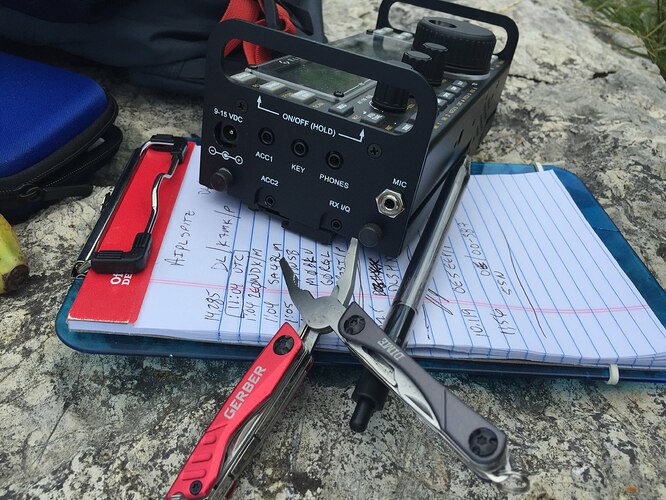I have already had to pack two of the newer type cable housings with epoxy resin as the plastic pillar accepting the screw broke. They are probably stronger after being filled with epoxy than when they are new. Not a major problem, but still let down by poor materials. I had to mend my friend Karl’s Elecraft MH3 microphone recently which had exactly the same problem: all three plastic screw pillars had snapped.
73 de OE6FEG
Matt
A gas soldering iron, small, like this one
can help… however I never carry it. ![]()
73s
Ingo
Andy,
Do you tape the coax to your pole at the top, with a loop of coax without any weight on it, so as to reduce the strain on the connector? I find the insulting tape is ideal for that and it seems to last about 20 activations before I have to get the roll and use new tape (gasp!) but then it gets stored on the bottom section of the pole, for re-use on the next outing. Also I find it helpful to have a small folded over section of tape, to be able to readily unwind it from where it is attached to the pole.
This loop system works for coax and for ribbon feedline.
73 Andrew VK1DA/VK2UH
Yes but not with tape. I wound some stiff hard-drawn copper wire around the feeder near the BNC ending in a hook. The hook clips over a tywrap on the dipole centre and so the weight of the cable is supported by this and hopefully the PVC and braid. There is no weight hanging on the connectors this way. The piece of RG174 on the dipole centre has the cable looped so it also has some strain relief. The result is the BNC on the dipole centre is still fine after 15 years use in all weathers and winds. It’s an RG58 cable socket and the body is backfilled with hot melt PVA glue to keep the water out. I’m going to say that applying strain relief and reinforcement to all connector / cable interfaces is why I have been so lucky with few issues over the years. Something I learnt working in the UK defence industry… about 80% of equipment failures/problems were connector related.
Now I have finally invested in a BNC crimp tool and some BNC crimp connectors there is no need for the PVA back filling. I should have bought the crimp tool years ago as it produces such beautiful results. I add just a few extra layers of heat shrink to add mechanical strength.
I also have a couple of these in the bag which are used to clip the feeder to the pole to stop it blowing about in the wind. They’re simple, cheap and light and you can fit/remove them with big gloves on.
Even better than insulting tape!
Just to be totally out of step with all the McGyver’s fixing stuff on the summit  I carry 2 antennas (trapped EFHW with a 70gm Mountain Tuner or sometimes a Fuchs tuner) and a backup random wire antenna. I reckon if something breaks it’s quicker (especially in winter) to just drop over the pole and replace the antenna rather than start a fiddly fix. Likewise in winter or harsher weather I’ll opt for my KX1 with internal batteries so if my Life connections break I’m still in the game. I usually use a palm paddle but have a back up homebrew key just in case
I carry 2 antennas (trapped EFHW with a 70gm Mountain Tuner or sometimes a Fuchs tuner) and a backup random wire antenna. I reckon if something breaks it’s quicker (especially in winter) to just drop over the pole and replace the antenna rather than start a fiddly fix. Likewise in winter or harsher weather I’ll opt for my KX1 with internal batteries so if my Life connections break I’m still in the game. I usually use a palm paddle but have a back up homebrew key just in case  Guess my winter mountaineering training in Scotland instructors got through to me about always having 2 maps and 3 pairs of gloves
Guess my winter mountaineering training in Scotland instructors got through to me about always having 2 maps and 3 pairs of gloves  Hi
Hi
Dec
ei6fr
I can see from my logs it took 30mins to fix the feeder first time. I reckon somewhere around -5C windchill and despite being in the lee of the summit, significant wind buffering. The wind was the worst part it makes it difficult to do things and more than anything, think clearly and analyse the problem.
The dipole centre is the single point of failure, I had 2 antennas and a short piece of RG188 (thinner, lighter than RG174) as an emergency feeder. I’ve needed that a few times. But only one centre. If I couldn’t have fixed it I would have cut the BNC off and stripped the cable to twist onto the antenna legs. I wouldn’t have admitted defeat too easily!
I have a Gerber Dime. Small and light enough to always have it with (i.e. lives in a pocket of my SOTA pack), but handy when you need it (like helping unscrew the KX3 bolts to change internal batteries on a summit!). Also have a small roll of electrical tape.
73, Jim K7MK
Guru,
Most salty, that Bosun’s pipe! Use one at home to announce to hummingbirds in the neighborhood, that the feeder has been re-filled. Use a (very loud) Storm whistle on the SOTA pack.
All Best, Ken K6HPX
I carry a Leatherman Surge multitool with me. Contains several tools (pliers, screwdriver, wire strippers/cutters, knife, etc) that can patch up something broken like an antenna well enough to save the activation. It probably won’t be pretty and will probably need to be fixed properly once back in the shack, but it’ll do.
